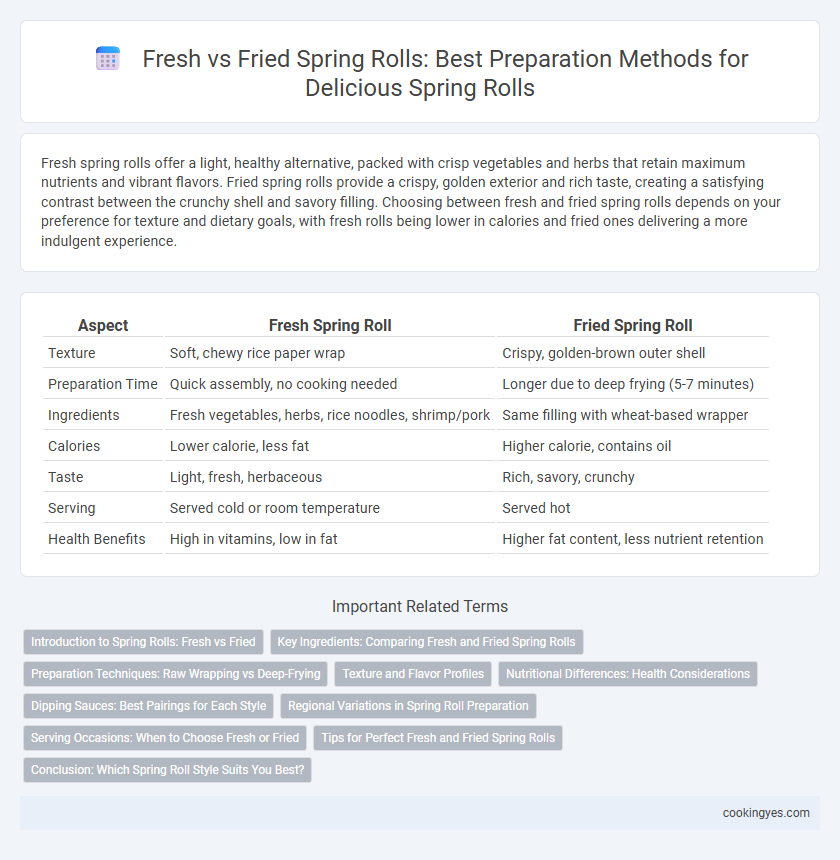Fresh spring rolls offer a light, healthy alternative, packed with crisp vegetables and herbs that retain maximum nutrients and vibrant flavors. Fried spring rolls provide a crispy, golden exterior and rich taste, creating a satisfying contrast between the crunchy shell and savory filling. Choosing between fresh and fried spring rolls depends on your preference for texture and dietary goals, with fresh rolls being lower in calories and fried ones delivering a more indulgent experience.
Table of Comparison
| Aspect | Fresh Spring Roll | Fried Spring Roll |
|---|---|---|
| Texture | Soft, chewy rice paper wrap | Crispy, golden-brown outer shell |
| Preparation Time | Quick assembly, no cooking needed | Longer due to deep frying (5-7 minutes) |
| Ingredients | Fresh vegetables, herbs, rice noodles, shrimp/pork | Same filling with wheat-based wrapper |
| Calories | Lower calorie, less fat | Higher calorie, contains oil |
| Taste | Light, fresh, herbaceous | Rich, savory, crunchy |
| Serving | Served cold or room temperature | Served hot |
| Health Benefits | High in vitamins, low in fat | Higher fat content, less nutrient retention |
Introduction to Spring Rolls: Fresh vs Fried
Spring rolls offer diverse textures and flavors through fresh and fried preparations, with fresh spring rolls typically featuring crisp vegetables, herbs, and protein wrapped in soft rice paper, providing a light, healthy option rich in nutrients. Fried spring rolls, on the other hand, deliver a crispy, golden exterior achieved through deep frying, enhancing flavor complexity and texture while adding calories and fats. These contrasting cooking methods influence taste, nutritional content, and cultural serving preferences, making spring rolls versatile in global cuisines.
Key Ingredients: Comparing Fresh and Fried Spring Rolls
Fresh spring rolls emphasize crisp, raw vegetables, herbs like mint and cilantro, and cooked shrimp or tofu wrapped in soft rice paper, providing a light and refreshing texture. Fried spring rolls use a similar filling but are encased in a thin wheat flour wrapper and deep-fried to achieve a crispy, golden exterior with a warm, savory interior. The key difference lies in the wrapper type and cooking method, where fresh rolls highlight the natural flavors of the filling, while fried rolls offer a crunchy texture and richer taste profile.
Preparation Techniques: Raw Wrapping vs Deep-Frying
Fresh spring rolls feature rice paper wrappers filled with raw vegetables, herbs, and often cooked proteins, offering a light and refreshing texture achieved through soaking the wrappers in water to soften them. Fried spring rolls undergo a deep-frying process, which crisps the outer layer and intensifies flavors by sealing in the hot, savory fillings inside a golden, crunchy shell. Preparation techniques significantly influence texture and taste, with fresh rolls emphasizing natural freshness and fried rolls providing a rich, crunchy experience.
Texture and Flavor Profiles
Fresh spring rolls offer a crisp, light texture with vibrant, herbaceous flavors from ingredients like mint, cilantro, and fresh vegetables, delivering a refreshing bite. Fried spring rolls provide a contrasting crunchy exterior and a richer, savory taste due to caramelization, enhancing the umami of fillings such as pork, shrimp, or mushrooms. Texture and flavor profiles differ significantly, with fresh rolls emphasizing freshness and moisture, while fried rolls highlight crispiness and depth of flavor.
Nutritional Differences: Health Considerations
Fresh spring rolls contain fewer calories and less fat compared to fried spring rolls, making them a healthier option for weight-conscious individuals. The absence of deep-frying reduces the intake of trans fats and cholesterol, lowering the risk of cardiovascular diseases. Nutrient retention is higher in fresh spring rolls due to minimal cooking, preserving vitamins and antioxidants found in fresh vegetables and herbs.
Dipping Sauces: Best Pairings for Each Style
Fresh spring rolls pair excellently with light, tangy dipping sauces like hoisin-peanut or nuoc cham, which complement their crisp, delicate textures. Fried spring rolls match robust, savory sauces such as sweet chili or soy-based dips, enhancing their crunchy, golden exterior. Choosing the right sauce elevates the overall flavor experience, balancing freshness or richness inherent in each preparation style.
Regional Variations in Spring Roll Preparation
Fresh spring rolls, popular in Vietnamese cuisine, emphasize crisp rice paper wrappers filled with fresh herbs, shrimp, and vermicelli, highlighting light and healthy flavors. In contrast, fried spring rolls, favored in Chinese and Southeast Asian regions, are characterized by their golden, crispy outer layers and savory fillings like pork, cabbage, or mushrooms, offering a rich, crunchy texture. Regional variations influence ingredient choices and preparation methods, reflecting local tastes and culinary traditions across Asia.
Serving Occasions: When to Choose Fresh or Fried
Fresh spring rolls suit light, refreshing meals and warm weather occasions, often served as appetizers or healthy snacks. Fried spring rolls are ideal for festive gatherings, dinner parties, or events requiring rich, crispy textures and heartier flavors. Selecting between fresh and fried depends on the meal setting, desired taste profile, and presentation style.
Tips for Perfect Fresh and Fried Spring Rolls
Achieving perfect fresh spring rolls requires using rice paper wrappers that are lightly moistened and filled with crisp vegetables, fresh herbs, and cooked protein to maintain a balanced texture and flavor. For fried spring rolls, ensure the filling is not overly wet to prevent sogginess and deep-fry at a consistent oil temperature of 350degF (175degC) until golden brown and crispy. Proper wrapping technique, avoiding air pockets, and serving immediately after frying are key to preserving the ideal texture and taste for both fresh and fried varieties.
Conclusion: Which Spring Roll Style Suits You Best?
Fresh spring rolls offer a light, healthy option rich in crisp vegetables and herbs, perfect for those seeking a nutritious, low-calorie snack. Fried spring rolls deliver a crispy, savory experience with a warm, golden exterior and a satisfying crunch, appealing to fans of classic comfort food. Your choice depends on dietary preferences and texture cravings, with fresh rolls ideal for freshness and health, and fried rolls suited for indulgence and flavor depth.
Fresh vs Fried for Spring roll preparation Infographic

 cookingyes.com
cookingyes.com